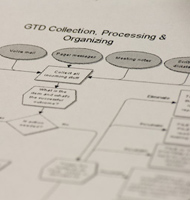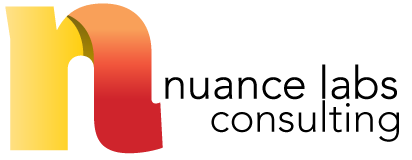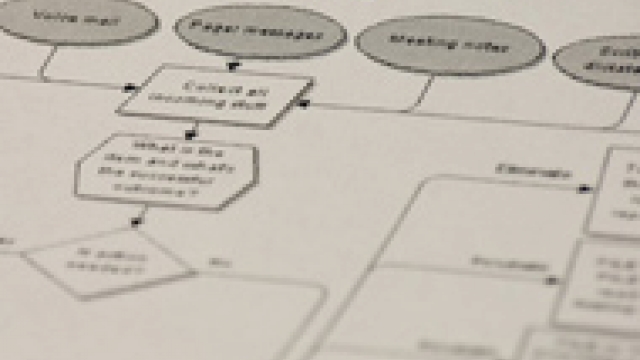
At this point in the start-up, a lot of people are visiting this site to get up to speed on who we are and what we’re building. Lawyers, potential investors, new contractors, and even hungry users are having to wrap their head around the mystery that is Nuance Labs, Inc. Not everyone, though, has heard of GTD. (Calm down, oh ye faithful! I speak the truth!) So, I thought I should write a little ditty on the basics, so, you know, our peeps can understand.
Here are our thoughts on the fundamentals, the core supporting pillars, of David Allen’s “Getting Things Done.” You might find a nugget of knowledge, if you will. Or a juicy tip, perhaps.
-
Record every important thought, when it hits you, so you forget nothing. Reminding yourself about important things is a habit built into most of us. Our brains are constantly reminding us, “Oh yeah, I need to call my sister!” So much so that we end up spending a small, but noticable, amount of mental power to track all of those things. For many people, all of that processing in the background translates into stress.
But, as you start to record those things in a way you can’t forget, your mind starts to relax. It doesn’t have to dedicate brain-time to make sure you haven’t forgotten something; you’ll know you can let it go, and the important things won’t be forgotten. You may even notice that stressful hum in your head start to dissipate.
The key is to find something that works for you, that you can always have with you, whether that’s a miniature notepad, a voice recorder, your mobile phone, your PDA, or a trusty friend who has any of those (just kidding.) Make it “muscle memory” to reach for your collection device of choice whenever an important thought strikes you.
-
Track everything that is time- or date-sensitive on your calendar. There are some things that happen, with or without your participation, on a certain day or time. For example, a music concert — unless you’re in the band, my guess is the band will play on without you. There are other things that you really need to do on a certain day or time, like have dinner with your wife on your anniversary (dinner may go on without you, but you’ll be in the cold, lonely dog house for sure.) These things are best tracked on a calendar.
Ideally, this calendar should be easy to refer to on a daily basis. Whether it’s a paper datebook, the datebook in your mobile phone or PDA, or iCalendar on your Mac, pick your favorite and use it religiously. Plus, now when people ask you, “Are you available for dinner next Tuesday?” you can mean it when you say, “I’ll have to check my calendar.”
-
Break your to-do lists down by when and where you can do those things. How many things can you think of, as you read this, that you know need doing? Yet, how many of those things can you actually do right now, where you are? I’d wager only a select few. Maybe you’re reading this from your home computer, and while you really need to buy some milk, you’re not at the grocery store. Or, maybe you’re using the RSS reader on your mobile from your car — not while driving, I hope! — and really can’t water the garden at the moment.
So, does it really make sense to track all of these actions on one big “to do” list? If so, every time you look at it, you’ll have to mentally filter out all the things you can’t do at the moment. It’s much easier to break your list into sections, or into multiple lists (your choice,) by “context.” Then, you just refer to the lists that are appropriate for where you are in your day, for the current “context.” For example, make a list of things you can do from your house such as water the garden, feed the dog, and check your mailbox. Make another list of the things you can only do at the office, or when you’re near a phone, commuting to and from work, and so on.
-
Single out the items that will take more than one step to finish and track them separately. Some things just can’t be done in one step. For example, having that anniversary dinner with your wife probably involves making reservations, buying flowers and a token of your love and, finally, actually eating dinner. By keeping track of each desired outcome on a “Projects” list, you can always refer to it and say, “Do I have each of these in motion?”
While it’s good to keep this list handy, you don’t necessarily need it with you at all times. The context lists are for use on the go. As long as you periodically check your “new thoughts” list for things that need to be tracked as projects, and update your context lists to make sure there’s at least one action representing each project, you should be good.
-
Clearly distinguish between things you are actively committed to completing and the things you’ll get to, but can’t focus on now. Life is always changing. One week, the most important thing in your world is to work on your new start-up business. But, just as you get into that, a tire blows out on your car and, for now, the start-up will have to wait. You need tires. If it’s not tires, it’s something else…a demanding boss, a spouse with some important “honey dos”, or a surprise visit from an out-of-town friend. Being able to rapidly re-focus, to respond to life’s surprises and keep on moving, is a core benefit of GTD.
-
Keep good reference systems. As you go through life, moving from task to task, you do a lot of research. You look up phone numbers, addresses, email addresses, and anything else you need. You also create a lot of useful documents like packing lists, meeting agendas, etc.
All of this information is useful. For example, if you make a packing list for a cruise, the chances are good that you’ll need mostly the same things on your next cruise. When you get back from your trip, update the list with anything you wish you had taken, then file it away. On the next cruise, you won’t have that nagging feeling that you left something at home. In how many other areas of your life could you apply this principle?
Good reference systems are essential. And you probably need more than one, depending on the types of things you store. For instance, a Rolodex or Address Book for contacts, a filing system for paper records, and a document repository for digital storage. Find a way to store all of the important artifacts of your life in a way that you will refer to them later. This is more art than science, and everyone will need their own system and method of organization to make this work. The value is the same, regardless of your particular choices; good reference systems will save you from repeating yourself, and serve as a useful personal resource in your life. The personal library of you.
-
Review often. The things we covered above only work if they are done consistently, and reviewed often for correctness. If there is an Achilles-heel to GTD, it would be that there is no autopilot. You do actually have to work it.
If you’re correctly juggling things between Projects and Someday/Maybe, each time you review will re-focus you onto the things that are most important given your new situation. Like a sailor, correcting and adjusting his course as he goes, so you will correct and adjust your trajectory as you move your life forward.
So, find a way to work it into your routine. Take a few minutes to check your context lists, making sure you have at least one action for each of your active projects. Juggle your projects between active and Someday/Maybe. Clean up your filing system, and make sure your inbox is empty. Done regularly, it’s not a lot of work.
More importantly, it’s not creating new work. If you choose to defer the planning that makes this system work, the decisions will still have to be made at some point; they don’t go away, you’ve just chosen to make them in the moment rather than planning ahead. If you choose not to keep a reference system, you’ll repeat the same activities without the benefits of historical documents. In the end, GTD actually does save you time and effort. It’s about doing more with less, not just doing more.
You’ll find an added advantage in organizing your “to do” list as described above. As you look at your “Near Phone” list to see who you need to call, you’ll see all of the calls you need to make. So, you can go ahead and knock a few more out, if you have the time. When you walk into Home Depot, you have a list of everything you’ve been meaning to buy, not just the one thing that brought you there. When you sit down to talk with someone, you have a list of all the things you meant to discuss with them, not just the one thing you sat down to discuss. The cumulative effect of doing this in every area of your life can be huge.
To make it work, don’t be afraid to push things off of your Projects list and onto a “Someday/Maybe” list. Keep your list of projects trimmed to the core commitments that you’d like to focus on now. Move everything else to Someday/Maybe. Each time you sit down to review your lists, you can always move something from Someday/Maybe back to Projects. It’s not lost, it’s just nicely tucked away until you’re ready to handle it.
By looking at everything that’s on your plate, you’ll get a strong sense of the things that need your attention immediately (new tires) versus the things that can wait (see a movie.) Use this sense of priority as your guide, juggling things in and out of view as you adjust to life’s surprises.
Feel free to share your thoughts on the above. Did I miss anything important, keeping in mind my focus on fundamentals? (There is a lot more to becoming a GTD ninja.) Any tips that help make the basics easier for you?


Splendid! I was just thinking of compiling a short-form version of GTD for my own reference, but I could have done no better than this. Many thanks!
Great summary. I tried to list the essential habits here, for comparison:
What are the essential habits of GTD?
http://ideamatt.blogspot.com/2006/07/what-are-essential-habits-of-gtd.html
A great break down! It reminds me how much there is to mastering GTD. It is simple, but deep.
I look forward to seeing your app – I’m always looking for productivity resources!